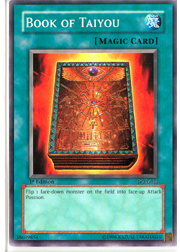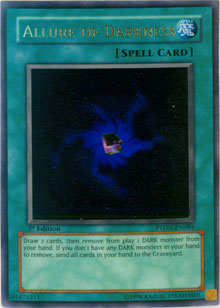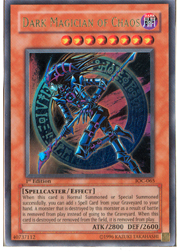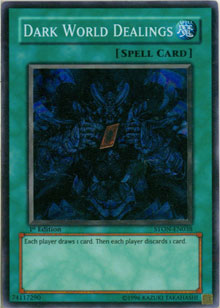This is a deck that dates all the way back to Michael Powers’ innovation at Shonen Jump Championship Houston in 2005. He took the combination of Dark Magician of Chaos, Dimension Fusion, Spell Economics, and a spell or monster to tribute the Magician for direct life point damage to an 11th place final standing: a heartbreaking result for the deck as it saw very little play at Shonen Jumps afterward. However, Justin Gillison, Paul McCann, and Erin Diaz brought the deck to Top 8 finishes at Shonen Jump Columbus 2008, three years later.
All three of the duelists pioneered very different versions of the deck, abusing completely different sets of cards introduced to the game since the deck’s premier in 2005. We’ll be looking at the vast and minor changes made to the deck by these players, discussing why they were so successful with the deck in this format, where the deck’s weaknesses are, and how to shift it into the format where it’ll become even faster: the Traditional format.
Powers’ Build
Monsters: 4
 1 Morphing Jar
1 Morphing Jar
1 Cannon Soldier
1 Cyber Jar
1 Dark Magician of Chaos
In this version, Powers is forced to make the deck incredibly focused. Without any of the more recent cards, he relied on Morphing Jar and Cyber Jar to create massive card-drawing engines. Reasoning and Monster Gate would thin his deck by an average of eight cards per use and retrieve either a piece of the combo (Cannon Soldier or Dark Magician of Chaos) or one of the Jars to start the card drawing.
 Once Powers obtained a Jar, he would abuse it (much like the "Empty Jar" deck) with three copies of both Book of Taiyou and Book of Moon. This was also during a time in which three copies of Scapegoat were allowed, achieving synergy with Monster Gate and slowing the game down to allow for his bad hands to work themselves out.
Once Powers obtained a Jar, he would abuse it (much like the "Empty Jar" deck) with three copies of both Book of Taiyou and Book of Moon. This was also during a time in which three copies of Scapegoat were allowed, achieving synergy with Monster Gate and slowing the game down to allow for his bad hands to work themselves out.
If Reasoning or Monster Gate gave Powers Dark Magician of Chaos (and even with the retrieval of a piece of the combo from his graveyard he was unable to begin the game-winning sequence of plays), he could retrieve a card-drawing powerhouse or Monster Gate and continue rifling through his deck. Perhaps the most amazing part of this build—especially considering the format in which it was played—was its ability to make the pieces of the combo that were in the graveyard just as useful as those in the hand. With Spell Reproduction, Dark Magician of Chaos, and Premature Burial, Powers had an incredible amount of options open to him once he played a copy of Reasoning or Monster Gate. No wonder he did so well at the Shonen Jump.
McCann’s Build
 Monsters: 14
Monsters: 14
1 Dark Magician of Chaos
3 Thunder Dragon
1 Toon Cannon Soldier
1 Destiny Hero - Disk Commander
2 Spell Striker
3 Cyber Valley
3 Destiny Hero - Diamond Dude
The most striking shift this build makes is that of the card-drawing engine. The first new addition to the deck is its ability to thin itself without actually drawing any cards. With two copies of Reinforcement of the Army, three Toon Table of Contents cards, three Thunder Dragon cards, and three copies of Upstart Goblin (which arguably does the same thing: not changing anything except taking another card out of the deck), the deck is in a sense only running 29 cards. Don’t forget that after the activation of Machine Duplication, two more cards are stripped from the deck! Even without drawing extra cards, it doesn’t take long for the graveyard to be taller than the deck.
With the introduction of Cyber Valley—a beautiful card-drawing engine or graveyard manipulation card—the deck finds new ways of sifting through itself. Spell Striker is a fast monster to give up in order to draw two cards from your deck, while Thunder Dragon allows you a free card to remove from play from your hand, in order to use Valley to put a card from your graveyard on top of your deck. Imagine playing Machine Duplication, special summoning Spell Striker, removing him and one of the Valleys from play to draw two cards (one of which is Dark Magician of Chaos), removing the Dark Magician of Chaos from play to put Dimension Fusion on top of your deck, and removing another monster and the final Valley from play to draw two more cards. Your Dimension Fusion now allows your Dark Magician of Chaos to retrieve the Dimension Fusion again, and you’ll have the ability to draw at least four cards! In a combo deck that is running virtually 29 cards, you’ve almost definitely won the game.
 The spell-based drawing power is nothing to scoff at either, featuring three copies of Allure of Darkness, Destiny Draw, and Magical Mallet. You’ll also have the one copy of Card Destruction, which shouldn’t take too much time to draw. Suddenly, a four-card combo doesn’t seem like much at all. And yet, the speed of the deck doesn’t stop there: Destiny Hero - Disk Commander and three copies of Destiny Hero - Diamond Dude provide even more speed.
The spell-based drawing power is nothing to scoff at either, featuring three copies of Allure of Darkness, Destiny Draw, and Magical Mallet. You’ll also have the one copy of Card Destruction, which shouldn’t take too much time to draw. Suddenly, a four-card combo doesn’t seem like much at all. And yet, the speed of the deck doesn’t stop there: Destiny Hero - Disk Commander and three copies of Destiny Hero - Diamond Dude provide even more speed.
Perhaps the most striking difference between this and the original build is its seeming lack of graveyard tricks. While this may seem like a weakness, it’s only been replaced by manipulation of the removed-from-play pile. Instead of being able to quickly create uses for cards in the graveyard, it makes enormous use of the remove-from-play pile, which has probably been the largest shift of the entire game since 2005. The trend of replacing graveyard manipulation with more overpowering removed-from-play manipulation has offered new options and fewer weaknesses to these decks. While graveyard tricks still exist in the form of Dark Magician of Chaos, Monster Reborn, and Premature Burial, the choice to leave Magical Stone Excavation out of the mix is perhaps indicative of the sweeping shifts of the game, something worth noting when you consider decks such as Dimensional Fissure and Gravekeeper’s.
Erin Diaz/Justin Gillison’s build
Monsters: 14
1 Dark Nephthys
 1 Dark Magician of Chaos
1 Dark Magician of Chaos
1 Dark Grepher
2 Destiny Hero - Dogma
3 Destiny Hero - Plasma
1 Elemental Hero Stratos
1 Shadowpriestess of Ohm
1 Destiny Hero - Disk Commander
3 Broww, Huntsman of Dark World
 These builds have once again changed the draw engine. By blending Broww, Huntsman of Dark World with spell-based card-drawing agents such as Dark World Dealings, Card Destruction, and Hand Destruction, cards that were already good in the deck become even better. Also, a Destiny Hero backbone is added to allow the abuse of a whopping nine copies of "Pot of Greed-type" cards: Trade-In, Destiny Draw, and Allure of Darkness. The largest difference between the draw engine of this deck and that of McCann’s is that it relies less on synergy. If McCann draws either Machine Duplication or Cyber Valley alone, they aren’t much help. While the three copies of Trade-In, Destiny Draw, and Allure of Darkness are similarly reliant, the Dark World Dealings and Hand Destruction aren’t necessarily dead cards (they just aren’t as good). On the other hand, this build can’t abuse Dimension Fusion with as much power before it retrieves the combo, while McCann’s build can use it to return Cyber Valley cards to the field to finish it. Also, McCann’s build is unaffected by cards like Dimensional Fissure, which only remove monsters from play. The Dark World monsters have to go to the graveyard to achieve their effects.
These builds have once again changed the draw engine. By blending Broww, Huntsman of Dark World with spell-based card-drawing agents such as Dark World Dealings, Card Destruction, and Hand Destruction, cards that were already good in the deck become even better. Also, a Destiny Hero backbone is added to allow the abuse of a whopping nine copies of "Pot of Greed-type" cards: Trade-In, Destiny Draw, and Allure of Darkness. The largest difference between the draw engine of this deck and that of McCann’s is that it relies less on synergy. If McCann draws either Machine Duplication or Cyber Valley alone, they aren’t much help. While the three copies of Trade-In, Destiny Draw, and Allure of Darkness are similarly reliant, the Dark World Dealings and Hand Destruction aren’t necessarily dead cards (they just aren’t as good). On the other hand, this build can’t abuse Dimension Fusion with as much power before it retrieves the combo, while McCann’s build can use it to return Cyber Valley cards to the field to finish it. Also, McCann’s build is unaffected by cards like Dimensional Fissure, which only remove monsters from play. The Dark World monsters have to go to the graveyard to achieve their effects.
Putting Their Brains Together
Apart from the draw engine, all three duelists were using the same backbone of the strategy. Obviously, the point of each deck is exactly the same as well: draw into the four cards of the combo and play them. The only difference between the decks is how they achieve that goal. This strategy has proven that it can stand its ground and out-speed even the Dark Armed Returns that litter the playing field, making it a wonderful choice to avoid playing the hard-to-find Dragon. To play this at a local level in Traditional format, we’re going to end the article with a version of Diaz/Gillison’s build moved into the Traditional format, as it benefits the most from the shift. However, the change isn’t going to be drastic since not many Traditional cards (other than the obvious card-drawing capabilities the format offers) are useful in the deck.
If you have trouble finding the changes, we’ve removed two cards: Dark Nephthys and Dark Grepher. We’ve replaced them with Graceful Charity and Pot of Greed. It’s going to take some serious thinking to deal with the massive changes I made to the deck, but it’s doubtful much explanation will be necessary to ease the transition (yup, that was indeed sarcasm).
See you next week!
—Ryan Murphy